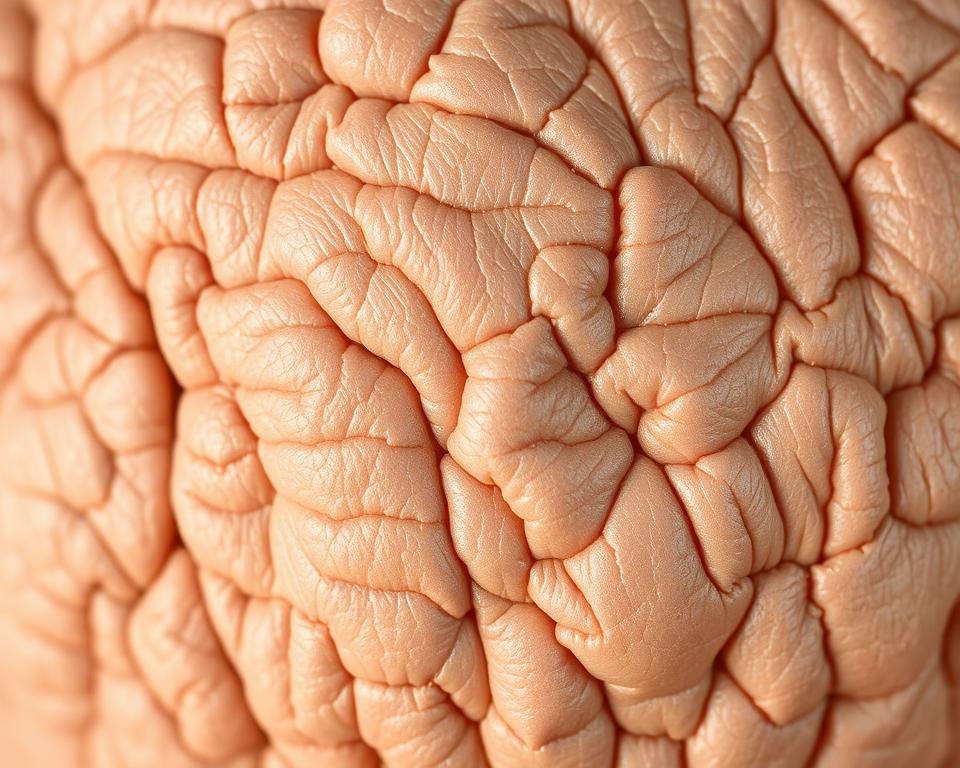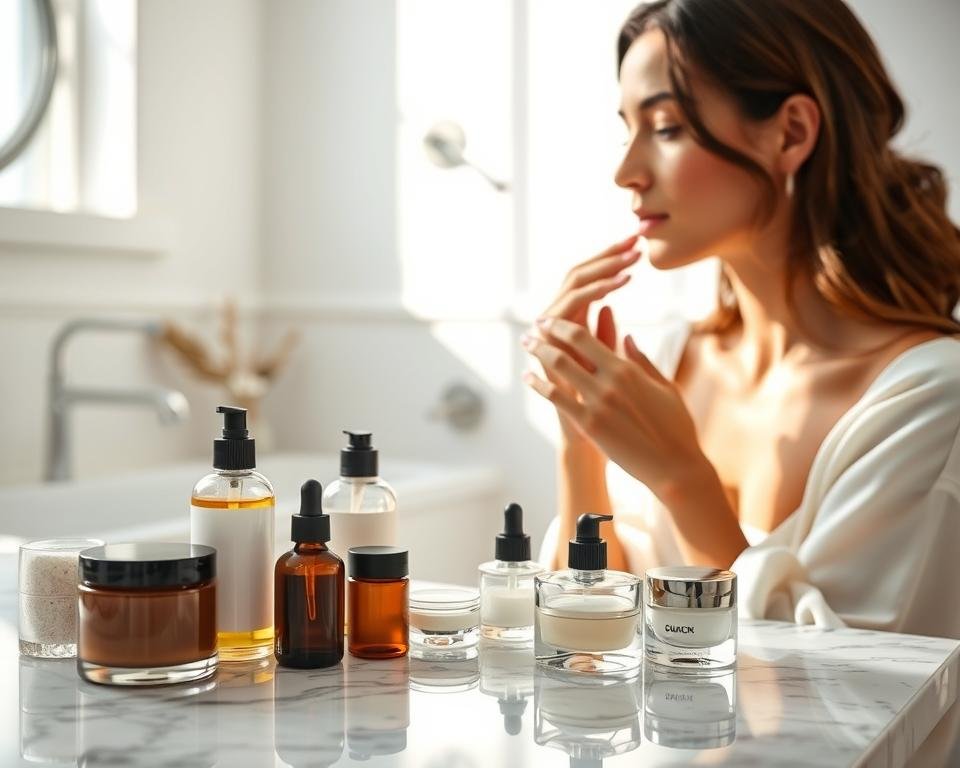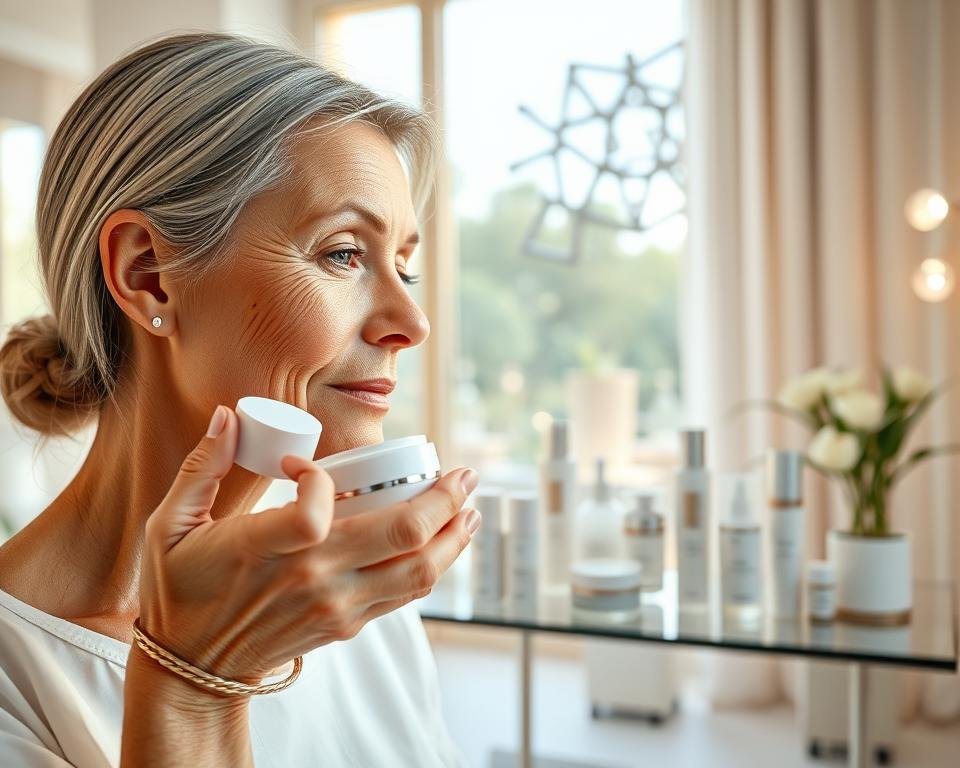“The beauty of a woman is not in the clothes she wears, but in the reflection of her heart.” Audrey Hepburn’s timeless words remind us that nurturing your body’s canvas—your skin—is an act of self-respect. Your dermis works tirelessly as a shield against pollutants, UV rays, and stress. Isn’t it time to return the favor?
A daily regimen tailored to mature complexions does more than smooth fine lines. It fortifies your natural barrier, locks in moisture, and combats visible signs of time. Think of it as armor for your body’s frontline defender—one that evolves with your unique needs.
Hydration isn’t just about drinking water. Lightweight serums, nourishing creams, and broad-spectrum SPF create layers of defense. Pair them with targeted treatments like peptides or antioxidants, and you’ll see lasting results. Consistency matters most—even basic steps, done right, can transform texture and tone.
Key Takeaways
- Your daily habits directly impact your complexion’s resilience and radiance
- Hydration and sun protection are non-negotiable for maintaining elasticity
- Quality formulas with active ingredients deliver better long-term outcomes
- Personalized approaches address specific concerns like dryness or sensitivity
- Preventive measures today reduce visible aging tomorrow
Understanding the Changes in Your Aging Skin
Your body’s protective layer evolves over decades, much like a favorite leather jacket softening with time. Collagen production drops by about 1% yearly after 30, while moisture retention weakens like a sponge left in the sun. These shifts create subtle fine lines that deepen into “expression maps”—crow’s feet from laughter or forehead creases from concentration.

Recognizing Signs of Skin Aging
Notice new shadows under your eyes? That’s thinning dermis revealing blood vessels. Rough patches and age spots often emerge from sun exposure, while dark spots might signal hormonal shifts. Your once-oily T-zone could now feel like parchment paper by noon.
Common Concerns: Age Spots, Wrinkles, and Dryness
Unlike temporary blemishes, age spots stick around like stubborn coffee stains. Wrinkles form where collagen networks fray, while dehydration exaggerates every line. Sensitive areas like cheeks may flush faster as protective oils diminish.
Track changes monthly using consistent lighting. A dated photo album becomes your best diagnostic tool. Spotting shifts early lets you choose products with hyaluronic acid for plumping or niacinamide for tone evening. Next, we’ll explore ingredients that actively reinforce your body’s changing armor.
Essential Skin Care for Aging Skin
Your body’s outer layer deserves the same precision as a master painter’s brushstrokes. A thoughtfully designed regimen acts like a multitasking toolkit—repairing past harm while shielding against new stressors. Let’s explore how strategic choices can revive your natural glow.
Benefits of a Targeted Routine
Custom formulas tackle multiple issues at once. Think of peptides rebuilding collagen networks while vitamin C brightens dullness. Studies show consistent use of hyaluronic acid boosts hydration by 40% in four weeks. Layering these power players creates a fortress against pollutants and UV rays.
Key Ingredients and Products to Look For
Dermatologists recommend these game-changers:
- Retinol: Smooths texture and accelerates cell renewal
- Niacinamide: Reduces redness and evens tone
- Ceramides: Reinforce moisture barriers weakened by time
Night creams with bakuchiol offer gentler alternatives to traditional treatments. For daytime, pair antioxidant serums with SPF 30+ moisturizers. Always check labels for non-comedogenic seals if you’re prone to clogged pores.
Remember: Results compound like interest. Six weeks of steady use reveals firmer contours and diminished shadows. Track progress with weekly selfies—your future self will thank you.
Building Your Daily Routine: Sunscreen, Moisturizer, and More
Think of your daily regimen as a three-legged stool—remove one pillar, and the whole structure wobbles. Morning and evening rituals should revolve around three non-negotiables: sun protection, deep hydration, and targeted treatments. Let’s break down how these elements work together like synchronized swimmers.

Your Daily Defense Against UV Rays
Dermatologists call broad-spectrum sunscreen “the ultimate time machine.” It blocks both UVA rays (which deepen lines) and UVB rays (responsible for burns). Look for SPF 30+ formulas labeled “non-comedogenic” if your face tends to get shiny. Reapply every two hours outdoors—set phone reminders if needed. “Sunscreen isn’t just for beach days,” notes Dr. Alicia Grant from the AAD. “Window light and cloudy skies still deliver aging rays.”
Moisturizer: The Glue Holding It All Together
Your moisturizer should match your skin type like a tailored suit. Oily complexions thrive with gel-based options containing hyaluronic acid. Dry types need richer creams packed with ceramides or squalane. Combination? Try a lotion that mattifies the T-zone while nourishing cheeks. Apply to damp face to lock in hydration.
Nighttime Treatments That Work While You Sleep
Retinol serums are the VIPs of evening care. They speed up cell turnover, smoothing lines and boosting collagen. Start with 0.25% strength twice weekly, increasing as tolerance builds. Layer it between toner and moisturizer. For sensitive skin types, bakuchiol offers similar benefits without irritation.
Pro tip: Apply products from thinnest to thickest texture. Cleanse → Tone → Serum → Eye Cream → Moisturizer → SPF (AM). Consistency turns these steps into habits—and habits become results.
Dermatologist Tips and Product Insights
Navigating the skincare aisle can feel like deciphering a foreign language—let’s translate the essentials. Board-certified dermatologists emphasize that effective regimens don’t require luxury price tags. “Start with sunscreen and moisturizer—they’re your foundation,” advises Dr. Lena Lee, a New York-based specialist. These two staples prevent skin cancer risks while addressing early signs of time’s passage.

Selecting Anti-Aging Products Within Your Budget
Overwhelmed by serums and creams? Focus on labels with non-comedogenic (won’t clog pores) or hypoallergenic (gentle on reactive types) claims. Many drugstore brands now include proven ingredients like retinol and vitamin C at half the cost of luxury lines.
Prioritize products backed by clinical studies over trendy additives. For example, laser treatments can refine texture but work best after establishing a consistent cleansing and hydration routine. “Invest in prevention first,” says Dr. Lee. “A $20 SPF moisturizer does more long-term good than a $200 cream correcting sun damage.”
Set realistic timelines—most formulas need 6-8 weeks to show results. If budget allows, consult a dermatologist for personalized advice, especially if you’ve had cancer scares or unusual mole changes. Many clinics offer virtual consultations for under $100.
Remember: Effective routines span price ranges. A basic trio—cleanser, SPF moisturizer, and night cream—often costs less than a weekly coffee habit. Upgrade gradually as you identify what your unique canvas needs.
Conclusion
Your journey to a healthier complexion starts with recognizing shifts like loss of firmness or new spots. By pairing sun protection with antioxidant-rich products, you create daily armor against environmental stressors. Research from clinical studies confirms that consistent routines improve texture and resilience over time.
Small steps matter. A morning SPF moisturizer and evening retinoid serum can dramatically slow visible changes. Customize your approach—what works for others might not suit your unique needs. Track progress through photos to spot improvements in appearance.
Remember: Prevention beats correction. Shield against dryness with ceramide creams and prioritize gentle exfoliation. Use dermatologist tips to navigate product claims without overspending.
Your body’s largest organ reflects your care. With patience and tailored habits, you’ll nurture lasting radiance—one thoughtful choice at a time.
